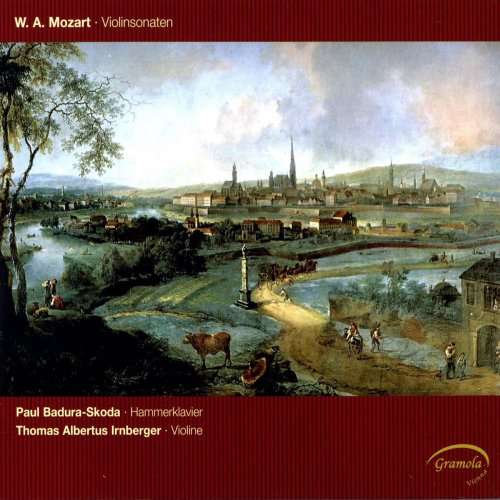
Thomas Albertus Irnberger, Paul Badura-Skoda - Mozart: Violin Sonatas (2005)
BAND/ARTIST: Thomas Albertus Irnberger, Paul Badura-Skoda
- Title: Mozart: Violin Sonatas
- Year Of Release: 2005
- Label: Gramola Records
- Genre: Classical
- Quality: flac lossless (tracks)
- Total Time: 01:05:39
- Total Size: 282 mb
- WebSite: Album Preview
Tracklist
01. Sonata for Keyboard and Violin No. 35 in A major, K. 526: I. Molto allegro
02. Sonata for Keyboard and Violin No. 35 in A major, K. 526: II. Andante
03. Sonata for Keyboard and Violin No. 35 in A major, K. 526: III. Presto
04. Violin Sonata No. 27 in G major, K. 379: I. Adagio
05. Violin Sonata No. 27 in G major, K. 379: II. Allegro
06. Violin Sonata No. 27 in G major, K. 379: III. Andantino cantabile
07. Violin Sonata No. 25 in F major, K. 377: I. Allegro
08. Violin Sonata No. 25 in F major, K. 377: II. Andante
09. Violin Sonata No. 25 in F major, K. 377: III. Tempo di Menuetto
This Gramola disc featuring the Mozart sonatas for keyboard and violin, K. 377, K. 379, and K. 526, is perhaps more interesting because of the instruments used than for the performances themselves. Fortepianist Paul Badura-Skoda plays on an instrument by the famed Viennese maker Anton Walter, the same maker responsible for producing Mozart's own much-adored instrument. Violinist Thomas Albertus Irnberger plays on a 1656 instrument of Jacobus Stainer, again the same maker responsible for Mozart's favorite violin, which in turn inspired the composition of K. 526. While the instruments heard in this recording are not the same owned by Mozart, it's reasonable to assume that they have a similar sound profile. Of the two musicians playing, Badura-Skoda offers the most musically enjoyable and technically accurate performance. His finesse on the Walter instrument is elegant, refined, nimble, and results in a pleasing palate of sound color that makes it easy to see why Walter's fortepianos were so venerated. The tone of the Stainer violin is equally focused and powerful, but Irnberger's playing falls far short of his collaborator. There are many inappropriate slides into big shifts, articulation is not always as crisp and precise as the fortepiano, and there is a definite tendency of Irnberger to rush ahead of the solid tempo laid out by Badura-Skoda. As a study of the sound quality of Mozart's instruments, this album is certainly worth checking out, but there are alternative recordings available that are more technically and musically balanced between the violin and keyboard parts.
01. Sonata for Keyboard and Violin No. 35 in A major, K. 526: I. Molto allegro
02. Sonata for Keyboard and Violin No. 35 in A major, K. 526: II. Andante
03. Sonata for Keyboard and Violin No. 35 in A major, K. 526: III. Presto
04. Violin Sonata No. 27 in G major, K. 379: I. Adagio
05. Violin Sonata No. 27 in G major, K. 379: II. Allegro
06. Violin Sonata No. 27 in G major, K. 379: III. Andantino cantabile
07. Violin Sonata No. 25 in F major, K. 377: I. Allegro
08. Violin Sonata No. 25 in F major, K. 377: II. Andante
09. Violin Sonata No. 25 in F major, K. 377: III. Tempo di Menuetto
This Gramola disc featuring the Mozart sonatas for keyboard and violin, K. 377, K. 379, and K. 526, is perhaps more interesting because of the instruments used than for the performances themselves. Fortepianist Paul Badura-Skoda plays on an instrument by the famed Viennese maker Anton Walter, the same maker responsible for producing Mozart's own much-adored instrument. Violinist Thomas Albertus Irnberger plays on a 1656 instrument of Jacobus Stainer, again the same maker responsible for Mozart's favorite violin, which in turn inspired the composition of K. 526. While the instruments heard in this recording are not the same owned by Mozart, it's reasonable to assume that they have a similar sound profile. Of the two musicians playing, Badura-Skoda offers the most musically enjoyable and technically accurate performance. His finesse on the Walter instrument is elegant, refined, nimble, and results in a pleasing palate of sound color that makes it easy to see why Walter's fortepianos were so venerated. The tone of the Stainer violin is equally focused and powerful, but Irnberger's playing falls far short of his collaborator. There are many inappropriate slides into big shifts, articulation is not always as crisp and precise as the fortepiano, and there is a definite tendency of Irnberger to rush ahead of the solid tempo laid out by Badura-Skoda. As a study of the sound quality of Mozart's instruments, this album is certainly worth checking out, but there are alternative recordings available that are more technically and musically balanced between the violin and keyboard parts.
As a ISRA.CLOUD's PREMIUM member you will have the following benefits:
- Unlimited high speed downloads
- Download directly without waiting time
- Unlimited parallel downloads
- Support for download accelerators
- No advertising
- Resume broken downloads


